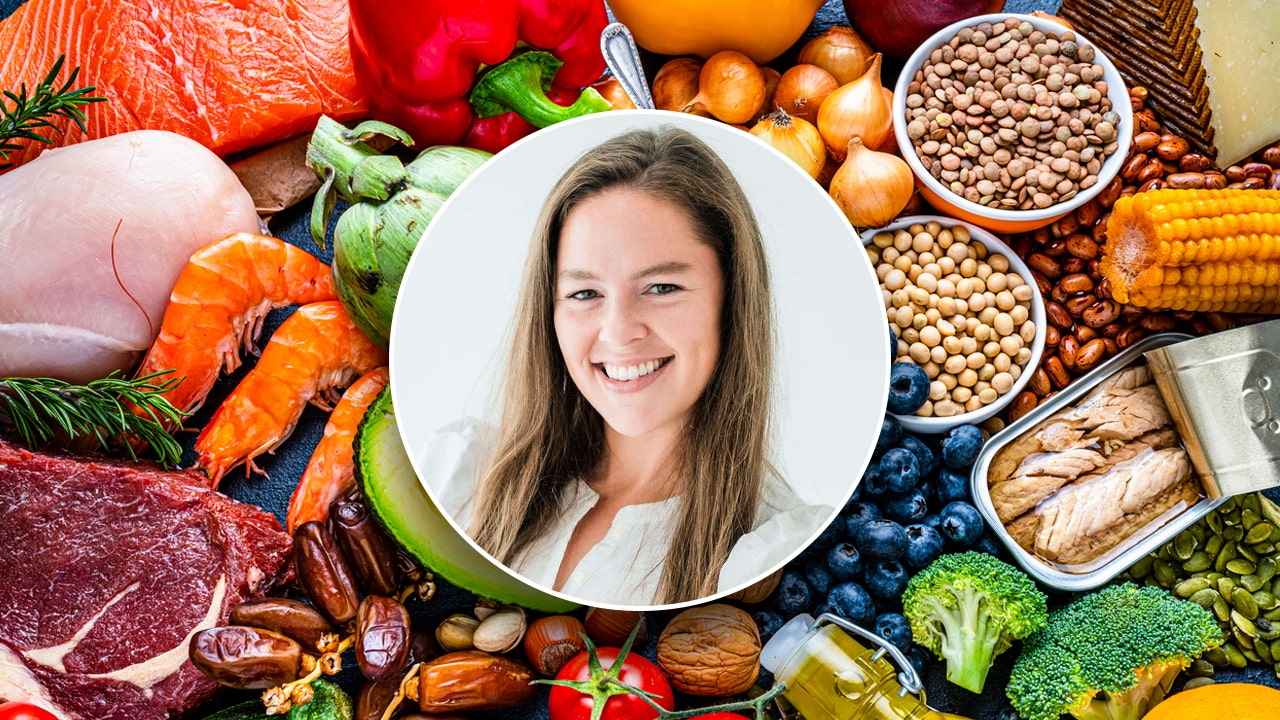Health
The cancer prevention diet: 6 smart tips from a nutritionist on what to eat and why — and what to avoid

Cancer has many risk factors. Some — like gender, age and family history — can’t be controlled. But others, like diet, can be managed.
Proper nutrition has been shown to reduce cancer risk, noted Dr. Brian Slomovitz, director of gynecologic oncology and co-chair of the Cancer Research Committee at Mount Sinai Medical Center in Miami Beach, Florida.
“First, we know that the rate of obesity is high and only increasing — and it’s a risk factor for many cancers,” he told Fox News Digital. “A healthy, balanced diet will help to decrease these cancers.”
ULTRA-PROCESSED FOOD CONSUMPTION LINKED TO HIGHER RISK OF DEATH FROM OVARIAN, BREAST CANCERS: NEW STUDY
A healthy diet may also limit fatigue and promote increased physical activity, which can also help with prevention, the doctor added.
Nichole Andrews, a registered dietitian nutritionist and cancer nutrition specialist, shared with Fox News Digital her recommendations for what to eat — and what to avoid — in order to reduce cancer risk. (iStock/Nichole Andrews)
Nichole Andrews, a registered dietitian nutritionist and cancer nutrition specialist who works with patients and survivors in Kennewick, Washington, shared with Fox News Digital her recommendations for what to eat — and what to avoid — in order to reduce cancer risk.
Here are her six tips.
1. Discover the power of plant-based eating
When it comes to building a lifestyle that reduces cancer risk, Andrews recommends making plant-based foods the centerpiece of meals.
“This means embracing a diet rich in fruits, vegetables, whole grains, legumes, nuts and seeds,” she said. “These foods are packed with essential vitamins, minerals, fiber and antioxidants that have been linked to a reduced risk of various types of cancer.”
THESE 10 NUTRITION MISTAKES COULD BE TAKING YEARS OFF YOUR LIFE: HERE’S WHAT TO DO INSTEAD.
In addition to lowering cancer risk, Andrews noted that prioritizing plant-based foods also provides the body with the nutrients it needs for overall health.
“Making these dietary changes can have a positive and lasting impact on your long-term health, whether you’re seeking to prevent cancer or reduce the risk of recurrence if you’re a cancer survivor,” she said.

Nichole Andrews works with patients and survivors in Kennewick, Washington. (Nichole Andrews)
Plant foods contain a symphony of health-protective nutrients, Andrews said, including vitamins, minerals, fiber, phytochemicals (which fight oxidative stress and inflammation, the roots of cancer) and antioxidants (which prevent harmful damage to healthy tissue).
“These food components have protective effects to slow the production of cancer cells through multiple mechanisms, such as apoptosis (cell death to unhealthy cells), DNA repair, hormone regulation and inflammatory responses,” she told Fox News Digital.
“Making these dietary changes can have a positive and lasting impact on your long-term health, whether you’re seeking to prevent cancer or reduce the risk of recurrence if you’re a cancer survivor.”
Dr. Amber Orman, a radiation oncologist and board-certified lifestyle medicine specialist for AdventHealth in Orlando, Florida, believes that up to 40% of all cancers could be prevented with a “plant-predominant diet combined with other aspects of lifestyle, specifically physical activity, avoiding tobacco and alcohol, and maintaining a healthy body weight,” she told Fox News Digital.
MORE YOUNGER PEOPLE ARE RECEIVING CANCER DIAGNOSES, STUDY FINDS — ESPECIALLY THIS TYPE
“Some of the most powerful anti-cancer foods include dark leafy greens, cruciferous vegetables, mushrooms, beans including soy, berries, unpeeled apples, ginger, garlic, turmeric, ground flax, and green tea with lemon,” Orman said.
“Also, look for locally grown, organic foods whenever possible.”
You do not have to go meatless or vegan to reduce cancer risk, Andrews pointed out.
“A plant-based diet includes all foods except processed meats and alcoholic beverages,” she said. “It is focused on two-thirds of the meals or snacks made up of vegetables, fruits, whole grains, beans, legumes, nuts and/or seeds.”

When it comes to building a lifestyle that reduces cancer risk, Andrews recommends making plant-based foods the centerpiece of meals. (iStock)
“Then the other third of the meal or snack is to be made up of dairy, eggs, lean animal protein, healthy fats and moderation of desserts.”
The key is to focus on adding more plant foods with all meals and snacks rather than focusing on what to eliminate, Andrews said.
“Think about adding specific foods to enjoy more or to reduce risk,” she added.
ASK AN EXPERT: ‘SHOULD I EXERCISE DURING MY CANCER TREATMENT?’
Slomovitz, for his part, pointed out that studies have shown that vegan diets may decrease the risk of cancer.
“Plant-based foods are of benefit to decreased risk,” he said. “However, compliance may be limited. It is not necessary to be vegan to be plant-based.”

Slomovitz pointed out that studies have shown that vegan diets may decrease the risk of cancer. (iStock)
“By definition, two-thirds of the diet should be plant-based and the other third can be lean animal protein or plant–based protein like protein or beans.”
Orman advises patients to think of animal products as “condiments” while increasing their plant intake. “Most of my patients consume a diet consisting of a minimum 80% plants,” she said.
2. Put the right proteins on your plate
Opting for non-processed meats and reducing red meat consumption in favor of lean protein sources like chicken, turkey, fish, seafood and plant proteins offer several cancer prevention benefits, Andrews said.
“These choices typically contain lower levels of saturated fats and heme iron, which are associated with an increased risk of cancer, particularly colorectal cancer,” she said.
“Building a cancer-prevention lifestyle doesn’t have to be overwhelming. Take small, manageable steps each day.”
“Additionally, white meats and fish are generally leaner, helping to maintain a healthy weight, which is crucial in reducing the risk of several cancer types,” she went on.
“By embracing these protein changes, individuals can reduce their exposure to potentially carcinogenic compounds and enhance their overall health, contributing to a lower risk of cancer development.”

“White meats and fish are generally leaner, helping to maintain a healthy weight, which is crucial in reducing the risk of several cancer types,” said Andrews. (iStock)
Andrews recommends incorporating the following nutritious protein options:
- Meat, poultry and eggs: Lean cuts of beef, lamb, goat, pork loin, skinless chicken and turkey, quail, duck, fortified omega-3 eggs
- Fish and seafood: Salmon, tuna, cod, shrimp, mackerel, lobster, catfish and crab
- Low-fat dairy foods: Yogurt, milk, cheese and cottage cheese
- Legumes: Beans, split peas, lentils and soy
3. Choose the right whole grains
Whole grains such as brown rice, whole wheat, quinoa and oats are rich in fiber, which aids in digestion and helps maintain a healthy weight — a key factor in cancer prevention, Andrews said.
“These grains also contain essential vitamins, minerals and antioxidants that combat inflammation and oxidative stress, both of which are linked to cancer development,” she noted.
THESE 5 STEPS CAN HELP YOU BUILD A BETTER BODY: ‘IT’S NOT ROCKET SCIENCE’
“Additionally, the fiber in whole grains can help regulate blood sugar levels and reduce insulin resistance, which may lower the risk of certain cancers like colorectal cancer.”
By choosing whole grains over refined grains, you can provide your body with a wealth of nutrients and protective compounds that can contribute to a reduced risk of cancer and better overall health, Andrews said.
4. Ensure sufficient fiber
As part of a cancer risk reduction diet plan, Andrews recommends aiming for a daily goal of 30 grams of fiber.

As part of a cancer risk reduction diet plan, Andrews recommends aiming for a daily goal of 30 grams of fiber. (iStock)
Below are some of her tips to increase fiber intake.
- Start your day with a high-fiber breakfast cereal or oatmeal.
- Swap white rice and pasta for whole grains like brown rice and whole wheat pasta.
- Incorporate legumes like beans and lentils into soups, stews and salads.
- Snack on fruits, vegetables and nuts instead of processed snacks.
- Include a variety of high-fiber foods in your meals, including artichokes, chia seeds, split peas, avocado, quinoa, raspberries, pear and barley.
“Incorporating these fiber-rich foods into your diet can significantly contribute to your daily fiber intake and help lower your cancer risk,” Andrews said.
5. Embrace healthy hydration
Alcohol consumption has been strongly linked to an increased risk of various types of cancer, including mouth, throat, esophagus, liver, breast and colorectal cancers, Andrews warned.
“Alcohol can damage DNA, promote inflammation and interfere with the body’s ability to absorb essential nutrients — all of which contribute to carcinogenesis,” the expert said.
GREATER NUMBERS OF WOMEN ARE DYING OF ALCOHOL-RELATED CONDITIONS, STUDY FINDS
To reduce this risk and prioritize a healthier lifestyle, Andrews recommends replacing alcoholic beverages with non-alcoholic alternatives.

Andrews recommends replacing alcoholic beverages with non-alcoholic alternatives. (iStock)
Here are seven beverage ideas:
- Sparkling water infused with citrus or herbs
- Herbal teas like chamomile or peppermint
- Fresh fruit smoothies
- Iced green tea lemonade
- Coconut water
- Unsweetened iced tea with lemon
- Homemade fruit-infused water
“These options not only quench your thirst, but also provide hydration and essential nutrients without the potential cancer risk associated with alcohol consumption,” Andrews said.
6. Lower sodium to reduce stomach cancer risk
Reducing daily sodium intake to no more than 2400 mg is crucial for lowering the risk of stomach cancer, said Andrews.
“Excessive sodium consumption can damage the stomach lining and increase the likelihood of developing stomach cancer,” she said.
CLICK HERE TO SIGN UP FOR OUR HEALTH NEWSLETTER
To achieve this goal, she offers three practical tips:
- Read food labels carefully, and opt for products labeled as “low-sodium” or “no added salt.”
- Limit processed and packaged foods, which are often high in sodium, and prioritize fresh, whole foods like fruits, vegetables and lean proteins.
- Use herbs, spices and natural flavor enhancers like garlic, lemon and vinegar to season your meals instead of salt.
“By adopting these strategies, you can significantly reduce your daily sodium intake and take important steps toward reducing your stomach cancer risk,” Andrews said.

“Building a cancer-prevention lifestyle doesn’t have to be overwhelming,” the expert said. “Instead, take small, manageable steps each day, focusing on one diet change at a time.” (iStock)
“Building a cancer-prevention lifestyle doesn’t have to be overwhelming,” the expert said. “Instead, take small, manageable steps each day, focusing on one diet change at a time.”
The key is to gradually incorporate healthier eating habits, she said, which will foster lasting results that you can integrate into your daily life with greater ease.
Slomovitz agrees that when deciding which diet is best, it is important to choose one that is not only healthy, but also sustainable.
“For example, switching to a plant-based diet has its benefits, but some individuals would find it difficult to follow,” he said.
“It is also important to consult with a dietician with specific concerns or questions.”

Health
FDA bans red food dye due to potential cancer risk

FDA looks to ban red food dye
Celebrity fitness trainer Jillian Michaels joins ‘Hannity’ to discuss the possibility of the FDA banning red food dye.
The U.S. Food and Drug Administration (FDA) has officially banned red dye — called Red 3, or Erythrosine — from foods, dietary supplements and ingested medicines, as reported by the Associated Press on Wednesday.
Food manufacturers must remove the dye from their products by January 2027, while drug manufacturers will have until January 2028 to do so, AP stated.
Any foods imported into the U.S. from other countries will also be subject to the new regulation.
RED FOOD DYE COULD SOON BE BANNED AS FDA REVIEWS PETITION
“The FDA is taking action that will remove the authorization for the use of FD&C Red No. 3 in food and ingested drugs,” said Jim Jones, the FDA’s deputy commissioner for human foods, in a statement.
The U.S. Food and Drug Administration has officially banned red dye — called Red 3, or Erythrosine — from foods, dietary supplements and ingested medicines (iStock)
“Evidence shows cancer in laboratory male rats exposed to high levels of FD&C Red No.3,” he continued. “Importantly, the way that FD&C Red No. 3 causes cancer in male rats does not occur in humans.”
The synthetic dye, which is made from petroleum, is used as a color additive in food and ingested drugs to give them a “bright cherry-red color,” according to an online statement from the FDA.

Food manufacturers must remove the dye from their products by January 2027, while drug manufacturers will have until January 2028 to do so. (iStock)
The petition to ban the dye cited the Delaney Clause, which states that the agency cannot classify a color additive as safe if it has been found to induce cancer in humans or animals.
The dye was removed from cosmetics nearly 35 years ago due to potential cancer risk.
CLICK HERE TO SIGN UP FOR OUR HEALTH NEWSLETTER
“This is a welcome, but long overdue, action from the FDA: removing the unsustainable double standard in which Red 3 was banned from lipstick but permitted in candy,” said Dr. Peter Lurie, director of the group Center for Science in the Public Interest, which led the petition effort, as reported by AP.

Nearly 3,000 foods are shown to contain Red No. 3, according to Food Scores, a database of foods compiled by the Environmental Working Group. (iStock)
Dr. Marc Siegel, clinical professor of medicine at NYU Langone Health and Fox News senior medical analyst, applauded the FDA’s ban.
“It was a long time coming,” he told Fox News Digital. “It’s been more than 30 years since it was banned from cosmetics in the U.S. due to evidence that it is carcinogenic in high doses in lab rats. There needs to be a consistency between what we put on our skin and what we put into our mouths.”
“There needs to be a consistency between what we put on our skin and what we put into our mouths.”
Siegel said he believes the FDA’s decision could be tied to the incoming new head of the Department of Health and Human Services, Robert F. Kennedy Jr.
“They knew it would have happened anyway under RFK Jr.,” he said. “It is already banned or severely restricted in Australia, Japan and the European Union.”

The food additive also “drew kids in” to a diet of empty calories and ultraprocessed foods, one doctor stated. (iStock)
The food additive also “drew kids in” to a diet of empty calories and ultraprocessed foods, Siegel added.
“It has also been linked to behavioral issues in children, including ADHD.”
Nearly 3,000 foods are shown to contain Red No. 3, according to Food Scores, a database of foods compiled by the Environmental Working Group.
For more Health articles, visit www.foxnews.com/health
The National Confectioners Association provided the below statement to Fox News Digital.
“Food safety is the number one priority for U.S. confectionery companies, and we will continue to follow and comply with FDA’s guidance and safety standards.”
The petition to remove Red No. 3 from foods, supplements and medications was presented in 2022 by the Center for Science in the Public Interest and 23 other organizations and scientists.
Health
How Yvette Nicole Brown Lost Weight and Got Her Diabetes Under Control

Sign Up
Create a free account to access exclusive content, play games, solve puzzles, test your pop-culture knowledge and receive special offers.
Already have an account? Login
Use left and right arrow keys to navigate between menu items.
Use escape to exit the menu.
Health
As bird flu spreads, CDC recommends faster 'subtyping' to catch more cases

As cases of H5N1, also known as avian flu or bird flu, continue to surface across the U.S., safety precautions are ramping up.
The U.S. Centers for Disease Control and Prevention (CDC) announced on Thursday its recommendation to test hospitalized influenza A patients more quickly and thoroughly to distinguish between seasonal flu and bird flu.
The accelerated “subtyping” of flu A in hospitalized patients is in response to “sporadic human infections” of avian flu, the CDC wrote in a press release.
ONE STATE LEADS COUNTRY IN HUMAN BIRD FLU WITH NEARLY 40 CONFIRMED CASES
“CDC is recommending a shortened timeline for subtyping all influenza A specimens among hospitalized patients and increasing efforts at clinical laboratories to identify non-seasonal influenza,” the agency wrote.
The CDC now recommends accelerated subtyping of influenza A in response to “sporadic human infections” in the U.S. (iStock)
“Clinicians and laboratorians are reminded to test for influenza in patients with suspected influenza and, going forward, to now expedite the subtyping of influenza A-positive specimens from hospitalized patients, particularly those in an intensive care unit (ICU).”
LOUISIANA REPORTS FIRST BIRD FLU-RELATED HUMAN DEATH IN US
The goal is to prevent delays in identifying bird flu infections and promote better patient care, “timely infection control” and case investigation, the agency stated.
These delays are more likely to occur during the flu season due to high patient volumes, according to the CDC.
For more Health articles, visit www.foxnews.com/health
Health care systems are expected to use tests that identify seasonal influenza A as a subtype – so if a test comes back positive for influenza A but negative for seasonal influenza, that is an indicator that the detected virus might be novel.

Identifying bird flu infections will support better patient care and infection control, the CDC says. (iStock)
“Subtyping is especially important in people who have a history of relevant exposure to wild or domestic animals [that are] infected or possibly infected with avian influenza A (H5N1) viruses,” the CDC wrote.
In an HHS media briefing on Thursday, the CDC confirmed that the public risk for avian flu is still low, but is being closely monitored.
CLICK HERE TO SIGN UP FOR OUR HEALTH NEWSLETTER
The agency spokesperson clarified that this accelerated testing is not due to bird flu cases being missed, as the CDC noted in its press release that those hospitalized with influenza A “probably have seasonal influenza.”
Niels Riedemann, MD, PhD, CEO and founder of InflaRx, a German biotechnology company, said that understanding these subtypes is an “important step” in better preparing for “any potential outbreak of concerning variants.”

The CDC recommends avoiding direct contact with wild birds or other animals that may be infected. (iStock)
“It will also be important to foster research and development of therapeutics, including those addressing the patient’s inflammatory immune response to these types of viruses – as this has been shown to cause organ injury and death during the COVID pandemic,” he told Fox News Digital.
Since 2022, there have been 67 total human cases of bird flu, according to the CDC, with 66 of those occurring in 2024.
The CDC recommends that people avoid direct contact with wild birds or other animals that are suspected to be infected. Those who work closely with animals should also wear the proper personal protective equipment (PPE).
-
/cdn.vox-cdn.com/uploads/chorus_asset/file/25822586/STK169_ZUCKERBERG_MAGA_STKS491_CVIRGINIA_A.jpg)
/cdn.vox-cdn.com/uploads/chorus_asset/file/25822586/STK169_ZUCKERBERG_MAGA_STKS491_CVIRGINIA_A.jpg) Technology1 week ago
Technology1 week agoMeta is highlighting a splintering global approach to online speech
-

 Science6 days ago
Science6 days agoMetro will offer free rides in L.A. through Sunday due to fires
-
/cdn.vox-cdn.com/uploads/chorus_asset/file/25821992/videoframe_720397.png)
/cdn.vox-cdn.com/uploads/chorus_asset/file/25821992/videoframe_720397.png) Technology1 week ago
Technology1 week agoLas Vegas police release ChatGPT logs from the suspect in the Cybertruck explosion
-

 News1 week ago
News1 week agoPhotos: Pacific Palisades Wildfire Engulfs Homes in an L.A. Neighborhood
-

 Education1 week ago
Education1 week agoFour Fraternity Members Charged After a Pledge Is Set on Fire
-

 Politics1 week ago
Politics1 week agoTrump trolls Canada again, shares map with country as part of US: 'Oh Canada!'
-
/cdn.vox-cdn.com/uploads/chorus_asset/file/23935558/acastro_STK103__01.jpg)
/cdn.vox-cdn.com/uploads/chorus_asset/file/23935558/acastro_STK103__01.jpg) Technology6 days ago
Technology6 days agoAmazon Prime will shut down its clothing try-on program
-

 News1 week ago
News1 week agoMapping the Damage From the Palisades Fire
/cdn.vox-cdn.com/uploads/chorus_asset/file/25829977/STK051_TIKTOKBAN_B_CVirginia_C.jpg)












